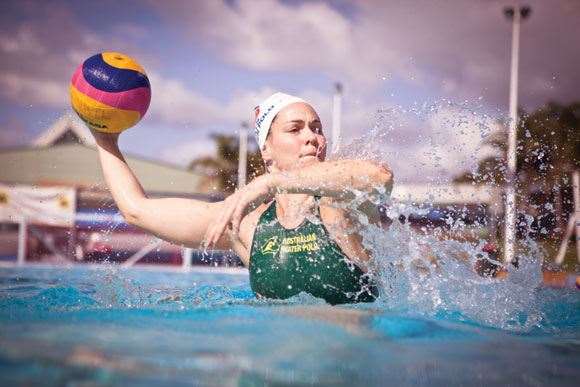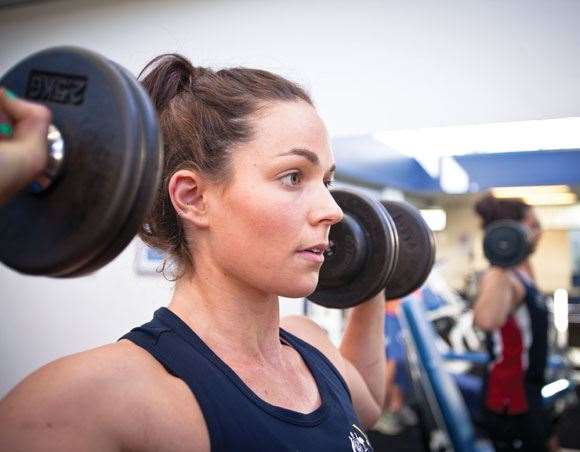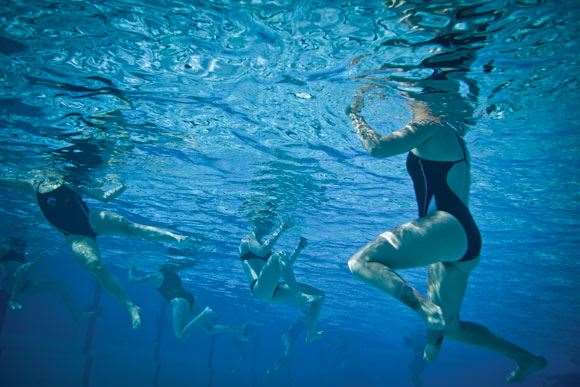Water polo is a sport made to measure for the Australian psyche: it’s rough, it’s tumble, and it’s played in water.
 Photos By, Shelby Hayden Craig
Photos By, Shelby Hayden CraigWater polo is a sport made to measure for the Australian psyche: it’s rough, it’s tumble, and it’s played in water.
Water polo is a sport made to measure for the Australian psyche: it’s rough, it’s tumble, and it’s played in water. With its end-to-end speed, its intricate tactics and its one-on-one battles, it’s damn-near footy in the briny. And yet, oddly, this game remains a bit player on our sporting stage. Indeed, if there was ever a match to lift this game into our collective gaze, then it was the women’s gold medal match at the Sydney Olympics. The Australian and American girls fought out a brutal contest; the locals hitting the lead, the Yanks gobbling it up. When the Americans nailed a levelling goal with 12 seconds on the clock, the match seemed destined for extra-time. Enter Yvette Higgins. With 1.3 seconds remaining, she unloaded a long-range, left-handed shot that clipped the fingers of two defenders before filling the American net. That 4-3 victory should, by rights, have dragged water polo out of its corner and dumped it in the deep end of Australian sport. Instead, the game slipped beneath the surface once more ...
Twelve years on, the Stingers (yep, that’s their name) will have another shot at Olympic glory. They’ve already qualified for the London Games and will fancy their chances against the Americans, the Chinese and the Euros ‒ all of whom have proven eminently beatable over the past few years. And if the Stingers are to take the top step of the London dais, they’ll need plenty from 21-year-old Sydneysider Nicola Zagame. Described by those in the know as one of the purest athletes in the women’s game, Zagame is the central support of the team’s defensive structure. Strong, fast and armed with a lethal right-handed outside shot, she could well prove the Stingers’ trump card come August.
On the move
“Growing up, I was always a driver, an attack player. I loved scoring goals – still do. But when I got into the national team, after the Beijing Games, a lot of the centre backs had just retired. Because I’m not a little girl, and because I’m quite strong, our coach Greg McFadden decided to convert me into a defender, into a centre back. Basically, that position allowed me to defend and attack – keep a few tricks up my sleeve. Training-wise, this meant I had to start doing a lot more leg work in the gym and the pool, getting my kick nice and strong. As a centre back, I have to do a lot of wrestling with centre forwards, whereas drivers tend to work more on ball skill exercises.
“The centre back is the leader in defence. You’re the key communicator who tells the other girls what type of defence you want. So again, training-wise, that meant I had to start watching a lot of game footage, doing my research. For me, the hardest thing was making all those decisions in defence, because previously I’d been the one following. I was only 18, so I found that adjustment really difficult. It was nerve-wracking ‒ I didn’t exactly know what I wanted from the other girls in defence.”
Battle plan
“There are so many different types of defence a team can adopt. There’s the full-pool press, where it’s just one-on-one with your team-mates, everyone pushed up heavy. Then there’s the three-back, where three people up the pool drop back. Then there’s the wing drop, or the ladder, or the counter attack defence ... There are so many types. In the pool, I just call a name and everyone knows what their role is. Then, from there, if they feel that another defence is required, they can tell me or tell the team. It’s a communication web – I just make the first decision and the rest of the strategy develops from that.
“Water polo’s a very intricate game. The coach and the assistant coach spend an infinite amount of time studying video footage of other teams. You’ve got the top nine teams in the world at the moment – Australia, USA, Canada, Russia, the Netherlands, Greece, Italy, Hungary and China – who are all so close that any given team can win on any given day. So tactics are really important.”
 Photos By, Shelby Hayden Craig
Photos By, Shelby Hayden CraigDefending the realm
“As a centre back, I mark the opposition centre forward – typically the biggest player in a team. There’s a centre forward in the Italian team called Elisa Cassanova and she is absolutely massive; 115kg at least. Believe me, marking a girl like her is hard work. When we’re playing Italy and I’m on Cassanova, that’s when team work really comes into play. We have to play zone defence – usually three-back – so I’m not just marking her one-on-one.
“I also have to make sure I work hard in attack, so she has to work hard up and down the pool. As soon as it’s our ball, I have to take off and Cassanova has to chase me up the pool; by the time it’s their ball, she has to sprint back down the pool in attack. Hopefully that tires her out. Because she’s such a big girl, her downfall is her swimming. But I definitely have to make sure I don’t get physically involved with her. When I’m marking her, I have to stay off her and swim around her, rather than wrestle with her, because there’s no way I can muscle up to her. That’s a big part of defence: choosing the time to muscle up to someone and choosing the time to use your speed rather than your strength.”
Firing line
“Even though I’m a defender, shooting’s a big part of my game. We all have to defend and we all have to attack. Just because I’m a centre back, it doesn’t mean I play centre back every defence ‒ quite often I’m one of the main attackers as well.
“With shooting technique, it’s important to get your whole body into the shot, not just your arms. Basically that means you have to get as high out of the water as possible by doing a hard eggbeater kick. There are two reasons for this. Firstly, it allows you to get over your defender. Secondly, the more of your body that’s out of the water, the less restriction you’re going to face in making the shot, so it allows you to shoot higher and faster.
“Once you’re up and out of the water, it’s important to have your left shoulder pointing to where you want to shoot. Then it’s all about getting the sequence right: your left shoulder goes first, then your right shoulder, then your arm. Your wrist should always be the last thing to flick. It’s all a big rotation. But shooting’s a very personal thing ‒ a lot of the girls have very different techniques. I’m more of a round-arm shooter, but a lot of the girls shoot straight up and down, over the top of their shoulder.”
Skill session
“In the water we do so much ball work. Passing drills, blocking drills, moving in the water with a ball, using our legs to propel us ... Again, with all these ball skills, it’s really important to get your legs working well, so when you’re throwing or catching the ball you’re as high in the water as possible. We do a lot of leg work drills where we’ve got the ball in our hand at the same time. Our coach also has a rule that we have to carry a ball at all of our sessions. While we’re at the pool we’re playing with the ball, fiddling with it, lifting our skills even though we’re not really thinking about it.
“It’s only in the last two years that we’ve started doing a lot of our ball work out of the pool. In fact, we’ve recently had an AIS basketball coach come down and show us some of their drills, so we can incorporate them into our ball work sessions. It’s been great practising a few moves that aren’t normally seen in water polo. We’ve incorporated some basketball picks and spins into our game, using some of the skills ... some of the different movements that basketballers use to get free in their game. In water polo you’ve typically got the centre forward who sits in front of the goal, but this coach explained that if the centre forward can come out and act as a blocker, then it allows the drivers to spin around her. Basically, it’s about having more attackers moving towards the goal. It’s really interesting getting another sport’s input. After all, water polo’s essentially a combination of basketball, soccer and European handball, but it’s in the water.”
Pool fit
“We do two or three swim sets a week, of about three and a half km s. They’re pure swim sets ‒ we never just swim three km s straight. We might have one session focused more on sprints, another focused on endurance.
“We also do aerobic power sessions ‒ these are the sessions we absolutely dread! Basically, these normally involve four three-minute blocks, with 30 seconds’ break in between each block. Each block is then filled with water polo-specific drills; so we might wrestle for ten seconds, then the coach will blow a whistle and we’ll have to sprint up the pool, then do ten water jumps, then sprint back and start wrestling again. It’s always a combination of getting physical and swimming. We also do sessions that combine swimming and ‘underwaters’. So we’ll push off the wall and go as far as we can underwater, then, when we surface, we have to sprint back to the wall. Basically, these sessions are all about building lung capacity. They also kill us!”
 Photos By, Shelby Hayden Craig
Photos By, Shelby Hayden CraigThe acid test
“We also do a lot of swim testing. A typical test is the 5x400m, where the finishing time goes down for every 400m block. These destroy us ... We also
do a swimming beep test. Basically, the intervals run at the same pace as the running beep test. We have to swim between two lane ropes 10m apart with the intervals between the beeps getting shorter and shorter the higher the stage. You just have to go and go until you miss the beep. It’s hard because there are lane ropes instead of walls, so you have to turn around in the water without pushing off. It sounds horrific, but it’s actually a lot easier than the 5x400s. We all prefer doing the beep test because, as soon as it gets too hard, you drop out, but with the 5x400s it’s just hard the whole time and you have to keep going.
“My best mark in the beep test is 12.3 – I think that’s the highest in our squad, actually. The aim for the centre forwards and centre backs is to get above level ten and the aim for the drivers is to get above level 11. Most of us are pretty good at reaching those goals.”
Weights for water
“In the gym, the focus is really the whole body. We do a lot of upper body work, with a focus on our lats for swimming and on our shoulders for shooting. We also do heaps of leg work; obviously our legs are working the whole game, trying to keep our heads above water. We do a lot of squats and power leg exercises like jump squats and lunges.
“As for sets and reps, it really depends on what training phase we’re in. In the pre-season we’re usually working on developing muscle strength, so we’re doing heavier weights – usually five sets of anywhere between four and ten reps. But going into a tournament, the focus is power, so that means higher reps, lower weight; more speed work with medicine balls and things like that. Within those phases the exercises themselves definitely change. Pre-season, we’ll do a lot of bench press, bench pulls, squats, chin ups. Going into a tournament, it’s more med ball work, more bodyweight exercises like push ups.”
By numbers
“With chin ups, my maximum is 12, which I think’s pretty good. For bench press, I can bench 82kg for one rep ‒ I only weigh 72kg, so I can do ten kilos above my body weight. With squats, my max is 85, and with bench pull my max is 75. But there are girls in our squad who push much bigger numbers than me – it really depends on the position you play as to what you’re better at. Centre forwards are normally bigger girls, so they’re not so good at body weight exercises, but they’re really good at squats, because they’re always using their legs to push around the defence, hold their position in the water. One of the centre forwards in our squad can leg press 320kg! Goalies tend to focus more on power and reflex exercises, so they also tend to be good at the leg work because they do a lot of plyometric exercises, a lot of box jumps in their program. And the drivers are typically the ones who are good at the bodyweight exercises because they tend to be a bit slimmer. One of the drivers in our squad can actually do 23 chin ups. Her name’s Jane Moran; she’s one of the shorter girls in our group but she’s a gun in the gym.
“Look at a team of 13 water polo girls and there’s always a massive variety of body shapes and sizes. Some girls are tall and slender; you take one look at them and know they’re an athlete. But some of the best players in the world don’t even look like athletes! Take Brenda Villa from the USA, for example. She’d be five foot six and she’s this tubby little thing ‒ but she’s such an amazing player. It really depends on your own style of play. Some girls are really big and they use their bulk to hold their position in the water. Other girls are slimmer and rely on their pace and agility.”
‒ Aaron Scott
Related Articles

Bronzed finish for Stingers at World Championships













